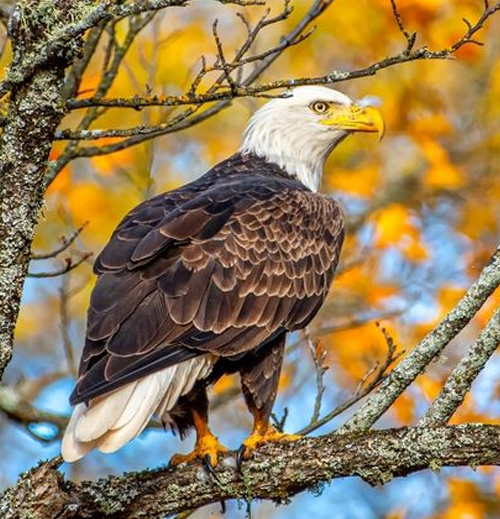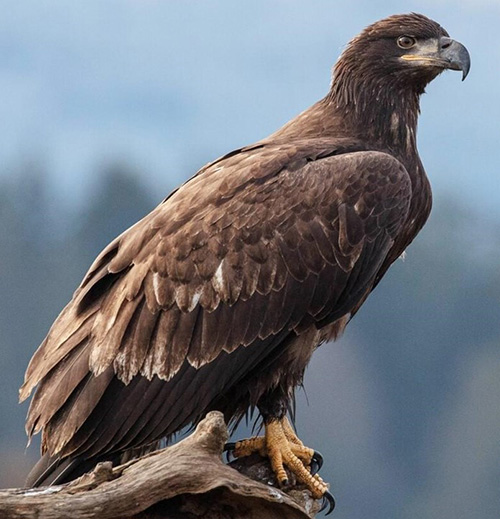Home → Fish & Wildlife → Wildlife → Species Information → Birds → Raptors
Raptors
The term “raptor” is derived from the Latin “rapere” meaning “to seize or take by force. ”There is a wide variety of raptors, but several traits are common to most of these birds:
- Talons are enlarged, curved claws for gripping prey.
- Beaks are relatively large and powerful for tearing flesh.
- Generally keen eyesight facilitates locating potential prey.
- Scavenging (eating carrion) is an option when food stressed.
- Wing shapes and size are specialized to aid foraging strategies.
- Females are larger than males (to varying degrees) amongst raptors.
Many people get only a fleeting glimpse of raptors and understandably wonder which one they saw!Learn to focus on the overall shape and silhouette proportions of those flying overhead.

There are many wonderful bird identification guides; here are a few links to useful raptor identification on-line that are especially applicable to Maine:
- Canadian Peregrine Foundation
- Cornell Lab of Ornithology
- Hawk Mountain Sanctuary
- Northeast Hawk Watch
Mankind has had a long fascination with raptors’ flight skills and hunting prowess. Declines in many raptor populations and conservation efforts to aid them have further elevated our awareness. Some raptors have had considerable conservation attention in Maine. Click on the header for additional information on bald eagles, golden eagles, and falcons. The “falcons” webpage features the peregrine falcon and Maine’s recovery efforts. The “nesting ecology,” “delisting,” and “research – longevity records” tabs on the bald eagle webpage provide many photographs and background on special topics.
ORDER FALCONIFORMES
Diurnal birds of prey that occur in Maine are in one of 4 taxonomic families.
- Family Accipitridae = hawks, eagles, and the northern harrier
- Family Falconidae = falcons
- Family Cathartidae = vultures
- Family Pandionidae = osprey
EAGLES
Only two types of eagles are native to North America. Both occur in Maine throughout the year. Except in midwinter, at least 2,000 bald eagles can be found across the state. Golden eagle almost certainly number < 100 individuals at any time of year: perhaps fewer than 10 in most months. More visit Maine as fall or spring migrants.
Bald Eagles are currently recognized as a State Species of Special Concern. Golden Eagles are a State Endangered Species. A federal law, the Bald Eagle – Golden Eagle Protection Act protects both species.
Join the Golden Eagle Community Science Project
FALCONS
Peregrine falcon, Waldo County
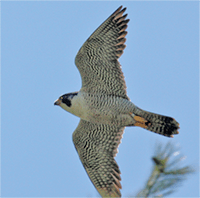
© Sharon Fiedler
Four members of the genus Falco can be seen in Maine. The Kestrels and merlins are broadly distributed but occur at low density; neither has a special status in Maine. Peregrine falcons are a State Endangered Species.
NORTHERN HARRIER
Northern harrier, Aroostook County

© Paul Cyr, Crown of Maine Photography
A Species of Special Concern in Maine
Harriers are often seen soaring low over fields and marshlands where they hunt. Wings raised in a “V” dihedral and a conspicuous white “rump” at the base of a relatively long tail are very characteristic. The loss of farmlands (especially pastures) is a setback for northern harriers and other grassland birds that nest on the ground. Harriers are one of the few raptors where the sexes have distinct plumages. Males have gray heads and backs, but are mostly white underneath. Females are brown above and “dirty white” underneath with dark streaks. Juveniles resemble females but tend to have rusty-tan colorations with streaking underneath.
OSPREY
Osprey and bald eagle in aerial combat,
Hancock County

© Sharon Fiedler
Osprey at nest, Waldo County
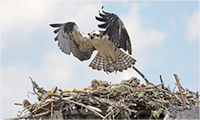
© Sharon Fiedler
The osprey is an abundant, widely distributed raptor in Maine. Once recognized as Endangered or Threatened in many other northeastern states, ospreys have never been listed in Maine.
The photo below reflects the intense competition between ospreys and bald eagles for nest locations and fish. Both are primarily fish eaters that build large stick nests, but the similarities diminish with further details or close-up viewing. Ospreys are smaller; whitish underneath; soar with wing tips arced downward below the horizontal; hover then dive for fish; and build nests atop trees, poles, cell towers, navigation markers, etc.
They can fish open waters and faster currents much more effectively than bald eagles. Ospreys are generally faster and more agile than eagles, but can fall victim to piracy when an eagle attacks while their flight is hampered by carrying a fish. Often, the osprey drops the fish as the eagle closes in. The eagle shifts attention to the fish and often catches it in midair:what entertainment!
WOODLAND HAWKS
BUTEOS:Three species of these relatively large-bodied, broad-winged raptors nest in Maine and are illustrated below. A fourth, the rough-legged hawk, is an occasional visitor during winter. Other buteo species occur elsewhere in the U. S. Buteos generally hunt in open areas and nest in the edges of forests. None of the buteos have special status designations in Maine.
Red-tailed hawk, Knox County
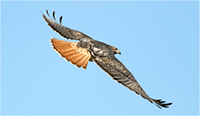
© Don Reimer
Red-shouldered hawk, Hancock County
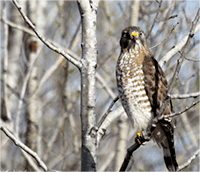
© Sharon Fiedler
Broad-winged hawk, Penobscot County
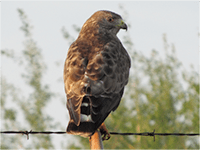
© Terry Spencer
Our largest nesting buteo, the red-tailed hawk is widespread across the state. It hunts larger openings like fields and clearcuts. Seen from the back, its brownish-red tail is distinctive. High overhead, it is fairly light underneath but a dark “belly band” is easily noticed. Many migrate but some linger during the winter and can be seen perched along highway medians.
This intermediate-sized Red-shouldered hawk frequents riparian forests. Earlier accounts of Maine birds in the 1900s labeled this as the most abundant raptor in the state:clearly not the current situation.
The broad-winged hawk is our smallest buteo in Maine. It is fairly plump compared to the smaller wingspan of red-shouldered hawks and especially the larger red-tailed hawk. It frequents the edges of woodlands, and is not an uncommon raptor to see perched on roadside utility lines.
Northern goshawk, AroostookCounty
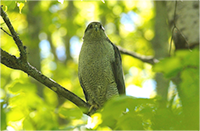
© Paul Cyr, Crown of Maine Photography
Cooper’s hawk, Penobscot County
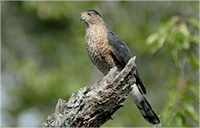
© Gail Smith
ACCIPITERS: Only 3 species live in North America, and all nest here in Maine. Accipiters have short, broad wings and notably long tails:features that serve them well while hunting in the interior of forests.
The sharp-shinned hawk (not pictured here) is quite similar to the Cooper’s hawk above. It is slightly smaller and more typical in the interior of Maine woodlands, while the Cooper’s hawk has adapted to fragmented, surburban areas. Look for subtle differences in the head feathering and contour of the tail feathers.
VULTURES
Turkey vulture, Aroostook County

© Paul Cyr, Crown of Maine Photography
Black vulture, Knox County

© Don Reimer
Three species reside in North America. Two are expanding their range in the eastern U. S. and are relatively recent arrivals to Maine. The turkey vulture is now widespread across Maine but was first documented as a breeding bird in the 1970s. Black vultures still occur sporadically in the state.
OWLS
Barred owl, Penobscot County
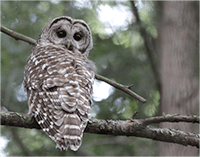
© Sharon Fieldler
Great horned owl, Aroostook County
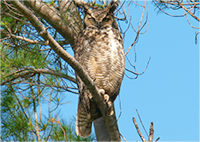
© Paul Cyr, Crown of Maine Photography
Long-eared owl, Aroostook County

© Paul Cyr, Crown of Maine Photography
Snowy owl, Aroostook County
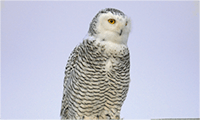
© Paul Cyr, Crown of Maine Photography
Northern hawk owl, Aroostook County
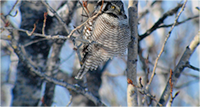
© Paul Cyr, Crown of Maine Photography
Great gray owl, Penobscot County
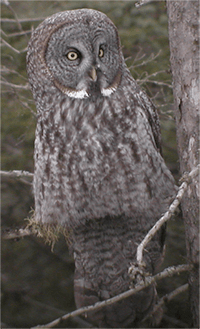
© Steve Mierzykowski, USFWS
Most typical owls in Maine (Order Strigiformes - Family Strigidae) are active at night (nocturnal) or at dawn and dusk (crepuscular). However, short-eared owls and northern hawk owls also hunt during daylight. Barn owls (Family Tytonidae) are former breeding residents of Maine.
Barred owls and great horned owls are widespread year-round residents of Maine. These large owls often occupy nests of crows or other raptors. Northern saw whet owls (not pictured here) are small owls that nest in Maine’s coniferous woodlands. The breeding population of short-eared owls (not pictured here) is designated a Threatened Species due to low numbers and vulnerability as a ground nester in grassland or expansive marshes. Short-eared owls are more frequently seen in Maine during migration and winter.
Several owls appear in greater numbers as winter visitors to Maine during food shortages in their breeding grounds across northern Canada and Alaska.
